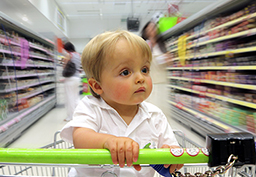July 26, 2019 — Environmental and children’s health advocates breathed a sigh of relief when, over a decade ago, U.S. manufacturers began to phase out a number of flame retardant chemicals from furniture, electronics, textiles and other everyday items. Polybrominated diphenyl ethers, or PBDEs, were facing increasing scrutiny (and some had already been banned in parts of Europe) for impacts on children’s brain development, hormone disruption, reduced fertility, and other adverse health effects, as well as for their ubiquity in the environment and persistence in the food chain.
 Today, though, these chemicals — which include tetra-, penta-, hexa-, hepta- and decaBDE; named according to the number of bromine atoms attached, but all are structurally similar and all tend to bioaccumulate — continue to turn up in people’s lives in everyday plastics, from kitchen utensils to children’s toys, but not because they’re still being used intentionally. Rather, they are inadvertently making their way into our lives as hitchhikers in products made from recycled plastics that contain them.
Today, though, these chemicals — which include tetra-, penta-, hexa-, hepta- and decaBDE; named according to the number of bromine atoms attached, but all are structurally similar and all tend to bioaccumulate — continue to turn up in people’s lives in everyday plastics, from kitchen utensils to children’s toys, but not because they’re still being used intentionally. Rather, they are inadvertently making their way into our lives as hitchhikers in products made from recycled plastics that contain them.
How exactly chemicals migrate from the plastic into our bodies is an ongoing area of study — do we absorb them through direct contact with the products? Ingest them somehow, or inhale? Studies done on these questions haven’t focused specifically on recycled products, but researchers have repeatedly found that products containing PBDEs release the chemicals into the air and onto dust; families then absorb them through simply breathing indoor air or through their skin by touching household dust. There’s little reason to think that whether a product contains PBDEs through recycled or new plastic makes any difference to how people may be exposed to the substances. Meanwhile, experts say there are better ways to recycle in order to, among other things, reduce the potential risks from chemical additives.
It’s a boomerang effect, says Karolína Brabcová, consumer campaigns coordinator for the Czech environmental organization Arnika. Also a parent, Brabcová is alarmed by the risks these chemicals pose for children in particular. Decades of research has suggested links between PBDEs and neurological deficits, among other health impacts.
“It’s the children who are most sensitive to it,” she says. “If a baby is affected by these chemicals, there’s no way to repair it.”
Arnika contributed to a report published in April by IPEN, a global network of NGOs focused on chemicals, which found PBDEs in children’s toys, hair accessories and other plastic products nearly everywhere they were tested, from Japan and Canada to the European Union and Brazil. It’s not a matter of price or quality; these chemicals can be in name-brand products just as much as generic or knockoff alternatives. The chemicals turn up most routinely in black plastic simply because that color is more likely to contain recycled plastic — it doesn’t need to be labeled as such, and in fact often isn’t — although they can and have appeared in other colors of plastic as well.
The IPEN report follows previous studies, such as one conducted in 2014 by researchers from the University of Antwerp that concluded, “Most likely, recycled materials are an important source of these additives in toys and therefore, their (re)use in products for children should be subject to stricter restrictions.”
“We just don’t know what’s in [these products] and there’s no way to find out,” says Brabcová. “The recyclers don’t know, the companies that sell the product have no idea because there’s no label, and there’s no way to follow these chemicals in the supply chain.”
That, she says, is the heart of the problem: Even when hazardous chemicals become regulated or restricted, the products that already contain them are not. Long-lasting chemicals like PBDEs persist in products and in the environment, and tend to bioaccumulate in people’s bodies, even after public outcries over their health effects and media buzz around new regulations die down.
“There’s not some sort of magic hole where they disappear,” says Andrew Turner, associate professor of marine geochemistry and pollution science at the University of Plymouth in England who published a paper last year on chemicals found in recycled black plastic. PBDEs and other substances are still with us, he says. “They’re just being incidentally put into all sorts of new products.”

PBDEs were detected in this toy gun bought in France at 1080 parts per million (ppm). To protect health, researchers and advocates have called for a limit of 50 ppm — with no amount proven safe. Photo courtesy of Marketa Sediva/Arnika Association (Czech Republic)
Just how wide-reaching and unpredictable the issue has become is exactly what the IPEN study was designed to illustrate, says Joe DiGangi, senior science and technical advisor at IPEN. “These flame retardant chemicals are ending up in products where they have no functional purpose,” he says. “When they appear there as a result of the recycling process, it illustrates quite clearly how that process results in a loss of control of those chemicals.”
This, DiGangi says, is a chief concern — the lack of data or any kind of tracking system for understanding which substances end up where. “If you’re not controlling for it or removing it deliberately, it will just go along for the ride,” he says.
And there are plenty of other chemicals that may also be present in recycled plastic that don’t need to be, including organophosphate flame retardant chemicals, which largely replaced PBDEs when they were phased out in new products, as well as things like BPA and phthalates — and potentially whatever the newest generation of concerning chemicals turns out to be.
Does It Need to Be This Way?
Advocates argue that it doesn’t need to be this way. There are policy and technological fixes to at least partially address the problem, but they are costly. For Arnika and other health and environmental organizations, a main focus of their attention is the Stockholm Convention.
The 2001 international treaty governs persistent organic pollutants (POPs) and has banned or restricted a number of brominated flame retardants — but it allows for exemptions for recycled products. The treaty’s expert committee on chemicals reviewed the recycling exemptions and reported the following year: “Failure to [eliminate brominated diphenyl ethers from the recycling streams as swiftly as possible] will inevitably result in wider human and environmental contamination and the dispersal of brominated diphenyl ethers into matrices from which recovery is not technically or economically feasible and in the loss of the long‑term credibility of recycling.”
DiGangi calls it a “double standard” to restrict chemicals in new but not recycled products. “Limits for new products are more stringent than those for recycled products,” he says. “That’s poisoning the circular economy.”
IPEN has called for the treaty to end the recycling exemptions, which are currently held by governments including the EU, Brazil, Canada, Japan and South Korea specifically for pentaBDE and octaBDE. The EU also has an exemption for combined totals for all PBDEs. (The U.S. is not party to the Stockholm Convention so doesn’t have exemptions; U.S. government and industry interests alike, though, may attend meetings as observers, giving them the opportunity for lobbying despite not being part of the official process.)
“A toxic chemical does not become less toxic when it is recycled,” Giulia Carlini, staff attorney at the Center for International Environmental Law, which has criticized the treaty’s stance on PBDEs, said in a press release in April. “The chemicals listed in the Stockholm Convention are the world’s worst chemicals.”
The health concerns related to recycled plastics extend beyond PBDEs. Dioxins, which are by-products of the flame retardants, can be present in the initial product or formed when the plastic is heated as part of the recycling process. Dioxins have been definitively shown to harm human health (as well as other animals), with a range of impacts at nearly every stage of development, including disrupting normal nervous system development, and impairing endocrine, immune and reproductive functions. While brominated dioxins are not listed under the Stockholm Convention, closely related chlorinated dioxins (which have been studied more extensively) are. When IPEN called for the recycling exemptions to be removed from the treaty, it also called for brominated dioxins to be added.
Solutions
PBDEs and dioxins in recycled plastics can, for the most part, be traced to electronics recycling. It’s a largely unregulated industry with little oversight — which results in serious and myriad health hazards for workers and local water supplies. This also means there’s little documentation of where different materials end up after they’re separated out from each computer, television and throwaway gadget. One 2015 study, for example, found that in Nigeria, one destination for developed countries’ electronic waste, a sample of nearly 240,000 metric tons (265,000 tons) of plastic from discarded televisions would contain almost 2,500 metric tons (2,800 tons) of octaBDE and decaBDE.

PBDEs were detected in this headband bought in Portugal at 2526 ppm. To protect health, researchers and advocates have called for a limit of 50 ppm — with no amount proven safe. Photo courtesy of Marketa Sediva/Arnika Association (Czech Republic)
The recycling process becomes a rich source of cheap black plastic. Aided by fast-moving global trade, these materials find their way into the faceless commodity market, and ultimately into products that consumers surround themselves with but give little thought to: hair clips, kitchen utensils, key fobs, children’s toys and more.
Inside the body, the chemicals operate gradually and invisibly; the health impacts they’re associated with don’t give early warning signs, and once the damage is done, it’s irreversible.
“If you see plastic pollution in oceans, it strikes you really easily, but this type of pollution is not as easy to grab. But you see the consequences [eventually],” says Brabcová.
For Miriam Diamond, earth sciences professor at the University of Toronto, it’s frustrating that PBDEs remain in circulation because of a lack of will, rather than lack of ability. They are not simple or cheap, but methods do exist for removing additives like PBDEs from plastics during recycling, and for destroying them safely. And those methods can also avoid releasing dioxins, for example, by not using combustion.
“All this is technologically possible, but it’s not economically feasible,” she says.
DiGangi says there are devices that can be used to separate plastics containing different chemicals — it’s how his colleagues did the study on hair clips and children’s toys — but there’s a simpler, low-tech way to sort them. Plastics with bromine are denser than those without, allowing them to sink in water, he says, and waste handlers in India already use this as a separation strategy.
“If waste handlers in India are able to separate these plastics using the sink-float method, I think any developed country can do it,” he says.
He points out that most countries in the world do not have the recycling exemptions to the Stockholm Convention. (Only seven governments do, though that includes the EU, representing its 28 member countries.) But products move so freely around the world, any countries that allow the continued use of these products open the door for them to end up anywhere. “It extends beyond the [six countries and the EU] that have asked for the exemption. And nobody knows where it is until you test for it,” he says.

PBDEs were detected in this toy car bought in Montenegro at 1805 ppm. To protect health, researchers and advocates have called for a limit of 50 ppm — with no amount proven safe. Photo courtesy of Marketa Sediva/Arnika Association (Czech Republic)
About the exemptions, Charlie Avis, spokesperson for the secretariat for the Stockholm Convention wrote in an email, “Exemptions and acceptable purposes give Parties the time that may be needed to adapt and take the necessary measures required by the Convention, in order to reduce or eliminate releases of POPs. This could be through finding alternatives, phase out of uses of POPs or other measures. … This is a dynamic issue, with numerous decisions related to exemptions and acceptable purposes having been adopted by the Conference of the Parties.”
DiGangi says that while that period of time is typically five years, governments agreed that the recycling exemptions could last until 2030 with a plan to review the exemptions in 2021.
Meanwhile, there’s really no way for average consumers to know which chemicals a given product contains. But as a practical tip for reducing contact with PBDEs and perhaps other chemicals carried over from a plastic product’s previous life, Turner advises people to avoid black plastic where possible.
Beyond such practical advice, Diamond is acutely focused on the bigger picture, and the continued use of all the other chemicals that haven’t been sufficiently studied or regulated at all yet.
“We also need to work as quickly as possible to restrict new uses [of inadequately tested chemicals],” she says. But this is an issue she connects to how much the economy has come to depend on product turnover and replacement — which is a much larger question than the PBDEs — similarly, with no simple fix. “Selling more stuff is the root of economic prosperity, and we haven’t figured out a way to be sufficiently prosperous without polluting ourselves.”
Related Posts
Ensia shares solutions-focused stories free of charge through our online magazine and partner media. That means audiences around the world have ready access to stories that can — and do — help them shape a better future. If you value our work, please show your support today.
Yes, I'll support Ensia!





